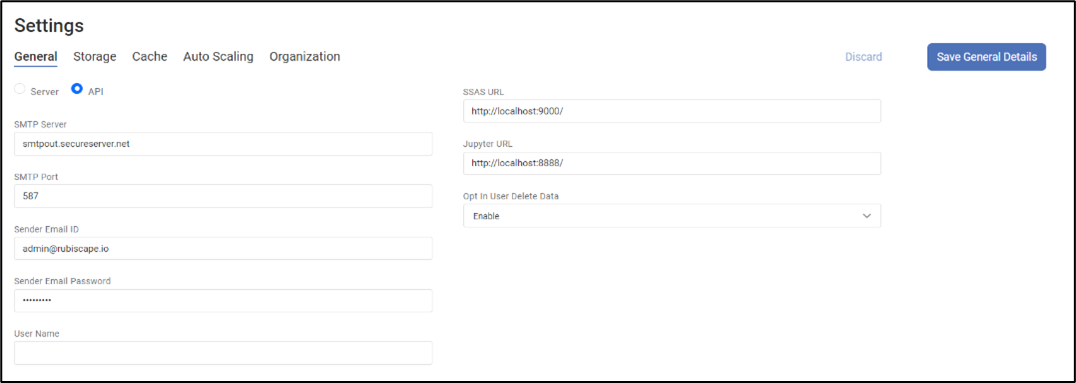General Setting
Using SMTP Server
General settings are applicable at the instance level.
These settings are useful for
- Any kind of scheduling activity. For example, scheduling a Workflow or a Dashboard.
- Running the SSAS and Jupyter URLs

The following table explains various fields in General settings.
Field | Description | Remark |
|---|---|---|
SMTP Server | Simple Mail Transfer Protocol Server. |
|
SMTP Port | Simple Mail Transfer Protocol Port |
|
Sender Email ID | Enter the email address you wish to be the default sender ID for all the scheduling purposes. | The Sender Email ID is used
|
Sender Email Password | Enter a valid email password for the above email ID. |
|
SSAS URL | SQL Server Analysis Services Uniform Resource Locator |
|
Jupyter URL | Jupyter Uniform Resource Locator |
|
Using SMTP API
While using API Option we have the following

All the Fields are same as that in case of SMTP Server Except User Name.
In user User Name is provided internally. so the user need not remember it. Also, If the password is reset at the source, then it needs to be updated in the application
|
|
Related Articles
Setting
When the Rubiscape platform is deployed on any instance, the configuration for that instance is monitored and modified using the Settings page. Note Only Superadmin can visit the Settings page to perform various configuration handling tasks. ...Storage Setting
In Rubiscape, the storage settings are at the instance level. Currently, Rubiscape supports five types of storage. You can select any storage as required. Note Only Superadmin can change the storage. Local (default) S3 on AWS MinIO Azure Blob Storage ...Setting Variable Values from Scheduled Pipeline Execution
This functionality allows users to assign specific values to pipeline variables at the schedule level. When a pipeline runs through a schedule, the variable values defined in that schedule override the global variable values. This enables dynamic, ...Geneal
General settings are associated with the line which is used to represent the Y-axis. The table given below describes different fields present in General formatting on Y-axis. Field Description Remark Width It allows you to select the width of the ...Unlock Value Axis in Dual Axis Chart
A secondary value axis (or Line Y-axis) appears when you plot a dual-axis widget (like the Combination Chart containing Columns and Line); a secondary value axis (or Line Y-axis) appears. Many times, the values of data points plotted on the Line ...